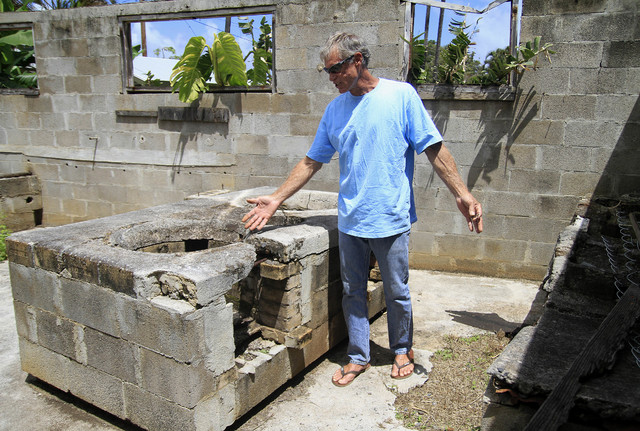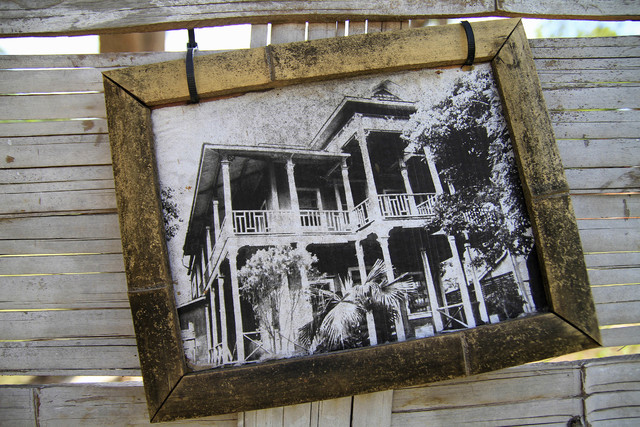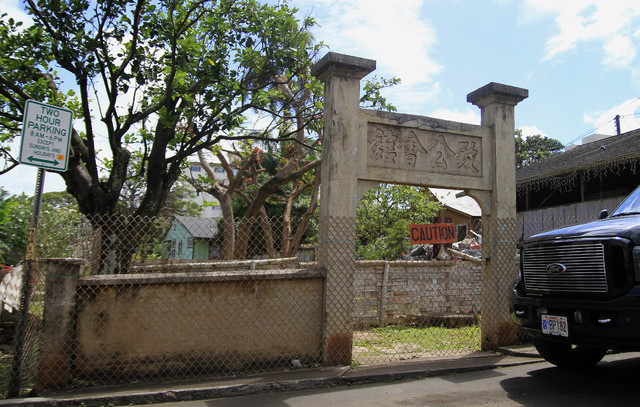Time running out for decades-old Chinese wall in Wailuku
WAILUKU — Randall Brokaw knows the clock is ticking for a possibly century-old Chinese wall, with ties to the venerable Dr. Sun Yat-sen, before it is destroyed or crumbles away in old Wailuku town.
Seated on a “flight of stairs to nowhere,” the property owner said he saw the historic Chinese building that once stood on the land collapse from termites, wood rot and neglect two decades ago.
Unless preservation work is done soon, he fears the wall is next, The Maui News reported.
“I don’t know how many more days it has,” he said looking at a massive truck parked in front of the wall. “A truck that size would take it out in a flash.”
The wall once provided the entry way to the Chee Kung Tong Society building located on 2151 Vineyard St. It is unclear when the wall and archway were built, but the former building was believed to have been built around the 1900s and collapsed in 1996.
The society’s two-story Wailuku building was the largest of six Chinese society halls built on Maui to serve as a gathering place for Chinese immigrant plantation workers. The surviving buildings are the Wo Hing Society Hall in Lahaina and the Ket Hing Society Hall in Kula.
The Wailuku hall was often used for society events such as celebrations and festivals. Its first floor housed Chinese language classrooms, according to a National Register of Historic Places nomination form. The upper floor was restricted to society members who would gamble, play fan tan games and smoke opium.
The building later housed elder members until the last resident died. Thereafter, it was abandoned.
Leigh Wai Doo, founder of the Sun Yat-sen Hawaii Foundation, said the Chee Kung Tong was one of the revolutionary parties that helped overthrow the Manchu government and “end 3,000 years of monarchial rule in China.” He was saddened to see the property in its dilapidated state.
“It’s highly unfortunate that the building has been lost,” said Doo, disappointed with the lack of respect, dignity and importance the property has received. “It’s as if we had not maintained a major building of the American Revolutionary War. It’s the birthplace of so many activities and should now be preserved as a land that is a significant part of Maui’s history.”
The Chee Kung Tong, known as the Chinese Freemasons, was a secret society of brothers under the Hoong Moon Fraternity that helped lead the Chinese revolution in 1911. Sun Yat-sen joined the fraternity’s Hawaii group in 1903 and won the support of the Chee Kung Tong, according to the book “Sun Yat-sen in Hawaii: Activities and Supporters.”
“The Manchu dynasty had an embassy in Honolulu and if they found out who was participating to form a revolution, not only was Sun Yat-sen’s head likely to be cut off, but also families faced punishment back in their hometown,” Doo said. “This society raised funds, and they raised support by sending people to go and fight” in the revolution, he said.
While the Chee Kung Tong Society building is recognized by the national registry, the Hawaii State Register of Historic Places delisted it following the collapse of the building. The building was described as having a Chinese dragon with two tails atop its roof, “glaring from a fierce head down on the passers by.”
Dr. Busaba Yip Douglas, cultural director of the Wo Hing Society Hall, said much of the information and materials are gone from the old Wailuku hall. She said she never entered the building before its collapse because it was too dangerous.
“We have nothing left now. It’s really sad because everything disappeared,” she said.
Brokaw, who bought the 4,800-square-foot property a few years ago, said much of the artifacts and materials were stolen before he got there. Homeless people camped out on the property and slept on mattresses inside a cinderblock kitchen area that is one of the few structures still standing.
“The whole place was full of junk,” he said. “It was a dump site. People would be drinking on the front porch when the bars closed and trash the place.”
As a teenager growing up a few houses down from the property, Brokaw said he remembers the building as a bustling area for the old “Hawaiian-Chinese mafia-types.” He said he later became friends with some of them and knew the last man who stayed in the house.
Brokaw finally decided to buy the property with some of his retirement money to prevent it from being destroyed and replaced by a parking lot.
“There’s still a lot of soul there, and it’s a very special place and should be preserved,” he said. “I’m just trying to do what I can, but I’m only one person.”
Preservation work for the wall would cost around $30,000, and Brokaw said he is willing to pay for it. Maui County spokesman Rod Antone said county officials have been working with Brokaw to process the necessary paperwork for work to begin.
“Mr. Brokaw is trying to do something worthwhile for the community, and the county wants to assist,” Antone said in a statement. “Hopefully, we can all get together and figure out how to do that.”
Department of Public Works Director David Goode said a land survey was completed Friday. It found that a few inches of the wall and archway encroach onto county property, but that won’t affect preservation work, he said.
“From our standpoint it’s good to go,” he said.
Goode said he is looking into alleviating the issue of cars parking on the curb and hitting the wall, which has contributed to the decay of the historic wall over the years.
Brokaw said he hopes to eventually see the building rebuilt in its original location. Foundation blocks still stand on the site, and building blueprints have been preserved, he said.
He plans to transform the property into a park and call it Sun Yat-sen Park Wailuku. It would have open park area in front of the building and along Vineyard Street. He also would like to restore the kitchen area so people could gather and eat.
Doo has been talking with Brokaw and welcomed the idea of a park and encouraged him to look for state and federal funding to realize his dream.
“That small site in Wailuku has the potential role of being Maui’s focal point for education, as it relates to the early Chinese, who helped build the Hawaii we know today,” Doo said. “We need to have a vision, and that vision should include Chee Kung Tong Society building site as a point of education and enjoyment as an open space and park.”





